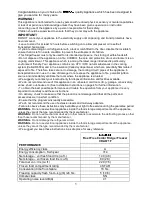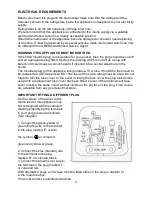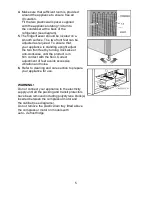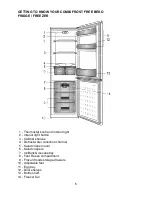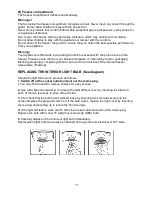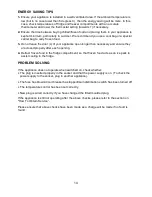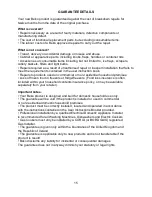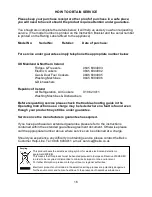
SUGGESTED ARRANGEMENT OF FOOD IN THE FRIDGE/FREEZER
Arrangement Examples (See diagram)
1. Baked, chilled cooked food,
dairy products, cans.
2. Meat, sausages, cold cuts.
3. Fruit, vegetables, salads.
4. Making, storing ice cubes.
5. Frozen food and freezing of fresh food.
6. Frozen food.
7. Butter, cheese, eggs, small bottles,
cans, tubes.
8. Tall, large bottles, beverages.
The following guidelines and recommendations are suggested to obtain the best
results and storage hygiene.
1. The fridge compartment is for the short term storage of fresh food and drinks.
2. The freezer compartment is rated and suitable for the freezing and storage
of pre frozen food. The recommendation for storage as stated on the food
packaging should be observed at all times.
3. Cooked dishes must be stored in airtight covered containers.
4. Fresh wrapped produce can be placed on the shelf. Fresh fruit and vegetables
should be cleaned and stored in the crisper bins.
5. Bottles can be placed in the door section.
6. To store raw meat, wrap in polythene bags and place on the lowest shelf. Do not
allow to come into contact with cooked food to avoid contamination. For safety,
only store raw meat for two to three days.
7. Keep the food packed wrapped or covered. Allow hot food and beverages to cool
before placing them in the fridge. Do not store explosive substances. High proof
alcohol must be stored upright in sealed containers. Left over canned food should
not be stored in the can.
8. Fizzy drinks should not be frozen and products such as flavoured water ices
should not be consumed too cold.
9. Some fruit and vegetables suffer damage if kept at temperatures near 0°C.
Therefore wrap pineapples, melons, cucumbers, tomatoes and similar produce in
polythene bags.
10. Place chilled cooked food and similar food near the rear of the fridge inner liner
where the cold wall is located.
11. Shelves, racks, crisper bins, drawers, flaps, bottle grippers are all removable.
12. Do not leave frozen food at room temperature to thaw; the best way to defrost food
is to put it in the fridge to thaw slowly. Make sure you avoid defrosting food or food
juices drip onto other food.
13. For hygiene reasons, always wrap food using a suitable packaging material before
storing in your appliance to avoid contact with the appliance surface.
8

